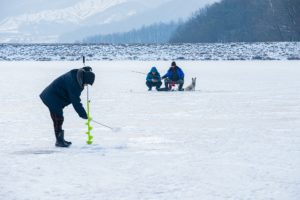With the advent of the winter season bringing cold temperatures all around and the usual lakes and other fishing spots freezing up, some curious anglers have taken to trying out different activities, like skiing. Other may still want to continue fishing, and as such have decided to try out ice fishing for the winter.
Thankfully, ice fishing is a relatively simple and easy to get into. Whether you’re a veteran angler or someone who’s holding a fishing rod for the very first time, ice fishing can be enjoyed by all.
For fishing beginners especially, this can be an opportunity to get into fishing as a whole. While ice fishing is much more specialized, thanks to being practically exclusive to the winter season due to requiring ice to fish on, it’s still relatively simple to get into. Most tips that you can learn as a beginner in ice fishing, you can carry over to regular fishing.
With all that said, here are some tips that beginners to the sport would want to know about and apply.
Check the thickness of the ice
Safety first! Whether you’re looking to skate on the ice or toss in your rod in the water, you need to make sure that the water can handle your weight in the first place! It might seem tempting to just jump on the ice with no care, especially since it looks quite solid… But looks can be deceiving.
Ice may not seem as solid as it actually appears. One wrong step can and will send you into the icy water below, freeze you up, and potentially cause hypothermia.
That’s why before even jumping on the ice, make sure to check how thick it is. For a human person, four inches of ice is the minimum requirement to hold your weight. Any less invites danger of the ice folding under your feet.
Wear appropriate clothing
This should go without saying. It’s winter, which means that it’s going to be quite cold outside. Make sure to pack enough layers to warm your body up so you don’t end up freezing while you fish.
It’s no fun to be distracted because of the cold, and it’s even worse if the fish gets away because you fumbled with your rod thanks to having cold and stiff hands!
Choose a proper fishing place
Not all places are suitable for ice fishing. Rivers and streams do occasionally freeze over, but their currents are usually too powerful to be frozen for long. And even if they do freeze over, the ice layer is usually so thin that it’s not worth fishing over. In fact, it may not even be able to reach the minimum 4 inches of ice that is needed to carry humans on the ice.
The best bodies of water in this case are those that are still with little to no movement from the water. Lakes are a great example of this. Lakes being large also means that you will have a lot of space to move around, provided of course that the water is sufficiently frozen to handle your weight.
Bring an experienced angling friend… or a guide.
The best way you can learn the ropes with ice fishing, really, is to have someone who is already experienced with it take you on and give you some lessons in real time. Guides on the internet are helpful, but can only take you so far, as most of the tips are more generalized to give people a better idea of what they should be focusing on their trips.
With a guide or a friend, they can be much more personal and adjust their teaching style on the more intricate details that a person may not notice, such as the angles of their throws, the bait that they use, and even how to make the most of the location they are in. Plus, it doubles as a safety measure. Having another person means that you can both watch each other’s back and notify authorities if things go south for either one of you.
Use a fish finder
In the olden days, you had to drill the ice and hope for the best that there are some fish chilling about below. It’s a traditional technique, but one that can be mundane and tedious, especially if you just can’t find the right spot, and considering how large a lake can be, you’ll take quite a while to find a proper fishing spot, to say nothing of all the holes you’re making that you might slip on and fall into.
Modern technology has made our lives much easier, as we can now use fish finders equipped with sonars that can detect objects that are underwater, making it much easier to pinpoint locations that may have large quantities of fish for you to catch.
Stick with one fishing technique first
Practice makes perfect. When it comes to ice fishing, there aren’t a lot of fishing techniques you can employ anyways, so it’s best to pick one that you’re comfortable with and stick with it.
You can eventually try and experiment with other techniques once you’ve grown accustomed to the one you started with to help you with future fishing trips.

